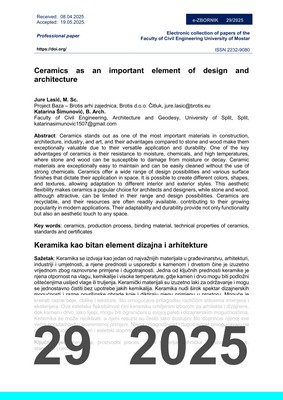ISSN 2232-9080 DOI: 10.47960/2232-9080
Search
CERAMICS AS AN IMPORTANT ELEMENT OF DESIGN AND ARCHITECTURE
- Issue: No. 29, June 2025, Vol. 15
- Author(s): Jure Lasić, Katarina Šimunović
- Type: Professional paper
- DOI: https://doi.org/10.47960/2232-9080.2025.29.15.84
Abstract: Ceramics stands out as one of the most important materials in construction, architecture, industry, and art, and their advantages compared to stone and wood make them exceptionally valuable due to their versatile application and durability. One of the key advantages of ceramics is their resistance to moisture, chemicals, and high temperatures, where stone and wood can be susceptible to damage from moisture or decay. Ceramic materials are exceptionally easy to maintain and can be easily cleaned without the use of strong chemicals. Ceramics offer a wide range of design possibilities and various surface finishes that dictate their application in space. It is possible to create different colors, shapes, and textures, allowing adaptation to different interior and exterior styles. This aesthetic flexibility makes ceramics a popular choice for architects and designers, while stone and wood, although attractive, can be limited in their range and design possibilities. Ceramics are recyclable, and their resources are often readily available, contributing to their growing popularity in modern applications. Their adaptability and durability provide not only functionality but also an aesthetic touch to any space.
Keywords: ceramics, production process, binding material, technical properties of ceramics, standards and certificates







